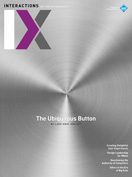Authors:
Ryuma Niiyama, Hiroshi Ishii, Sean Follmer, Sheelagh Carpendale, Emre Karagozler, Ivan Poupyrev, Gary Fedder, Yuri Suzuki, Lining Yao, Jifei Ou, John Brosz, Miguel Nacenta, Richard Pusch, Christophe Hurter, Jun Rekimoto
The Paper Generator is a new energy-harvesting technology that generates electrical energy from user interactions with paper-like materials. These energy harvesters are flexible, lightweight, and inexpensive. They utilize a user's gestures such as tapping, touching, rubbing, and sliding to generate energy.
The harvested energy is used to actuate LEDs, e-paper displays, buzzers, and other devices to create interactive applications for books, postcards, posters, and other printed media.
http://www.disneyresearch.com/project/paper-generators/
https://www.youtube.com/watch?v=4WaUcXSfPTg
Karagozler, M.E., Poupyrev, I., Fedder, G.K., and Suzuki, Y. Paper Generators: Harvesting energy from touching, rubbing and sliding. Proc. of UIST'13. ACM, New York, 2013.
M. Emre Karagozler, Disney Research
[email protected]
Ivan Poupyrev, Disney Research
Gary K. Fedder, Carnegie Mellon University
Yuri Suzuki, Disney Research
Inspired by ocean organisms that morph and move bodies without rigid skeletons, PneUI (p'newee) is an enabling technology to build shape-changing interfaces through pneumatically actuated soft composite materials. The composite materials integrate the capabilities of both input sensing and active shape output. This is enabled by the composites' multilayer structures with different mechanical or electrical properties. The shape-changing states are computationally controllable through pneumatics and predefined structure. The design space of PneUI is explored through four applications: height-changing tangible phicons, a shape-changing mobile device, a transformable tablet case, and a shape-shifting lamp.
http://tangible.media.mit.edu/project/pneui-pneumatically-driven-soft-composite-material/
Yao, L., Niiyama, R., Ou, J., Follmer, S., Della Silva, C., and Ishii, H. PneUI: Pneumatically actuated soft composite materials for shape changing interfaces. Proc. of UIST'13. ACM, New York, 13–22.
Lining Yao, MIT Media Lab
[email protected]
Ryuma Niiyama, MIT Media Lab
[email protected]
Jifei Ou, MIT Media Lab
[email protected]
Sean Follmer, MIT Media Lab
[email protected]
Hiroshi Ishii, MIT Media Lab
A transmogrifier is a novel interface that enables quick, on-the-fly graphic transformations. An image region can be specified by a shape and transformed into a destination shape with real-time visual feedback. Both origin and destination shapes can be circles, quadrilaterals, or arbitrary shapes defined through touch. Transmogrifiers are flexible, fast, and simple to create and invite use in casual InfoVis scenarios, opening the door to alternative ways of exploring and displaying existing visualizations (e.g., rectifying routes or rivers in maps), and enabling free-form prototyping of new visualizations (e.g., lenses).
http://www.transmogrifiers.org/
https://www.youtube.com/watch?v=S1Roi2NOmx8
Brosz, J., Nacenta, M.A., Pusch, R., Carpendale, S., and Christophe Hurter, C. Transmogrification: Casual manipulation of visualizations. Proc. of UIST'13. ACM, New York, 2013, 97–106.
John Brosz, University of Calgary
Miguel A. Nacenta, University of St. Andrews
[email protected]
Richard Pusch, University of Calgary
[email protected]
Sheelagh Carpendale, University of Calgary
[email protected]
Christophe Hurter, University of Toulouse
This research introduces a mechanism to induce a virtual force based on human illusory sensations. An asymmetric signal is applied to a tactile actuator such that the user feels the device is being pulled or pushed in a particular direction, although it is not supported by any mechanical connection to other objects or the ground. The proposed device is smaller and lighter than any previous force-feedback devices. This small form factor allows the device to be implemented in several interactive applications, such as a pedestrian navigation or an untethered input device with virtual force.
http://lab.rekimoto.org/projects/traxion
Rekimoto, J. Traxion: A tactile interaction device with virtual force sensation. Proc of UIST'13. ACM, New York, 2013, 427–432.
Jun Rekimoto, The University of Tokyo and Sony Computer Science Laboratories
[email protected]
 Figure 1. Paper Generator harvests energy from rubbing and activates the e-paper display, revealing the word hello.
Figure 1. Paper Generator harvests energy from rubbing and activates the e-paper display, revealing the word hello.
 Figure 2. By increasing air pressure, the surface of PneUI's elastic fabric deforms.
Figure 2. By increasing air pressure, the surface of PneUI's elastic fabric deforms.
 Figure 3. Transmogrification of a Nightingale chart (left) into a bar chart (right).
Figure 3. Transmogrification of a Nightingale chart (left) into a bar chart (right).
 Figure 4. Traxion is a virtual force-inducing device based on asymmetric acceleration.
Figure 4. Traxion is a virtual force-inducing device based on asymmetric acceleration.
©2014 ACM 1072-5220/14/05 $15.00
Permission to make digital or hard copies of all or part of this work for personal or classroom use is granted without fee provided that copies are not made or distributed for profit or commercial advantage and that copies bear this notice and the full citation on the first page. To copy otherwise, to republish, to post on servers or to redistribute to lists, requires prior specific permission and/or a fee.
The Digital Library is published by the Association for Computing Machinery. Copyright © 2014 ACM, Inc.








Post Comment
No Comments Found